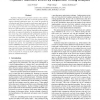Free Online Productivity Tools
i2Speak
i2Symbol
i2OCR
iTex2Img
iWeb2Print
iWeb2Shot
i2Type
iPdf2Split
iPdf2Merge
i2Bopomofo
i2Arabic
i2Style
i2Image
i2PDF
iLatex2Rtf
Sci2ools
ICCAD
2004
IEEE
2004
IEEE
Physical placement driven by sequential timing analysis
Traditional timing-driven placement considers only combinational delays and does not take into account the potential of subsequent sequential optimization steps. As a result, the potential of re-balancing path delays through post-placement applications of clock skew scheduling and in-place retiming cannot be fully realized. In this paper we describe a new placement algorithm that is based on a tight integration of sequential timing analysis in the inner loop of an analytic solver. Instead of minimizing the maximum path delay, our approach minimizes the maximum mean delay on any circuit loop, thus enabling the full optimization potential of clock skew scheduling and in-place retiming. We present two versions of the new algorithm: one approximates sequential criticality and weights wires accordingly [1], the other extends this with the inclusion of explicit wire-length constraints for loops that limit the final clock period. Our algorithms are implemented using a hybrid, GORDIAN-style ...
Clock Skew Scheduling | Combinational Delays | Hardware | ICCAD 2004 | Presented Placement Algorithm |
| Added | 16 Mar 2010 |
| Updated | 16 Mar 2010 |
| Type | Conference |
| Year | 2004 |
| Where | ICCAD |
| Authors | Aaron P. Hurst, Philip Chong, Andreas Kuehlmann |
Comments (0)

